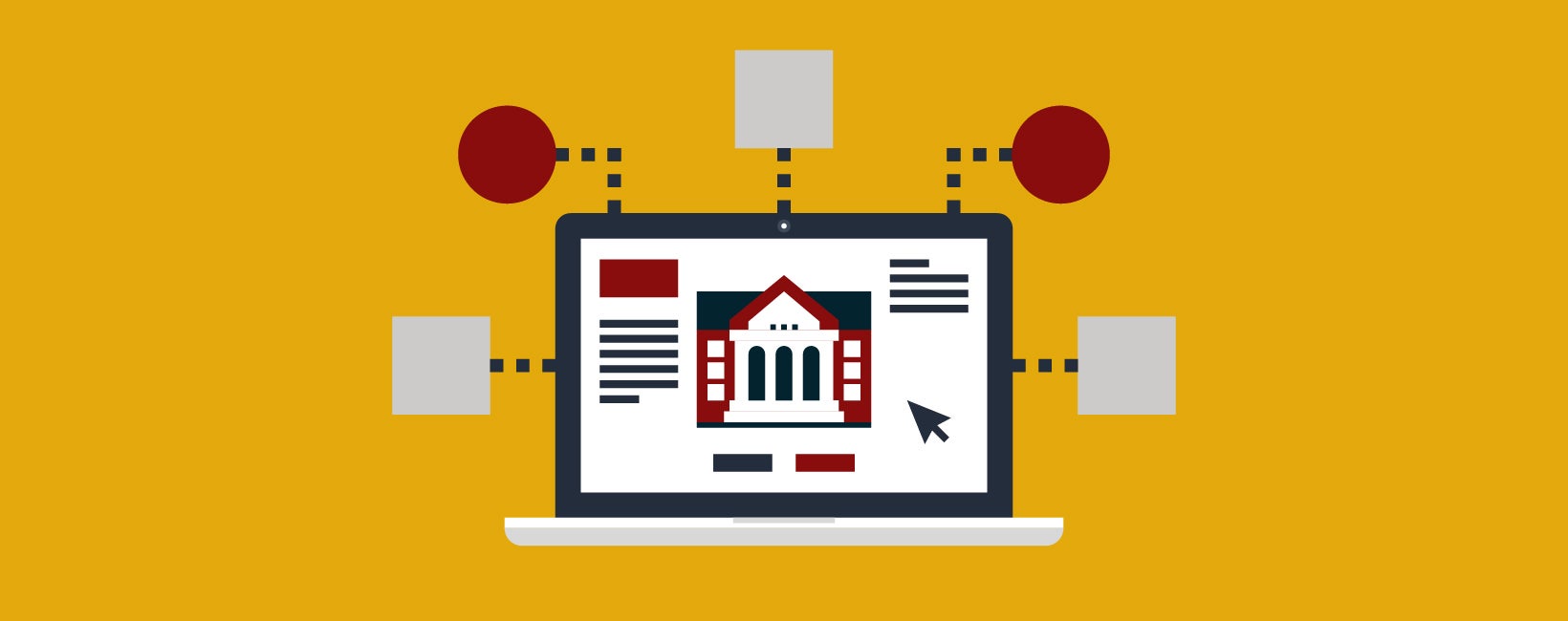 Dec 14, 2020
Persona
Dec 14, 2020
Persona
You’ve heard it before: Your website is the most important marketing tool in your toolkit. And you’ve heard that 2020 has been “unprecedented,” “unlike any other year,” and so forth. What do those two facts have in common? The COVID-19 pandemic has dramatically altered the way people interact with websites. It’s altering the way people consume information and find your website. And it’s underscoring the importance of websites.
Your .edu is an essential destination for all the audiences you care about. But it’s especially important to prospective students and their parents, and it will continue to play a key role in virtually every aspect of the decisions they make regarding college search and choice. It’s more important than ever that your website provides thorough, well-rounded insights into your institution. It’s past time to shape it up to meet the changed landscape.
Why now, “more than ever”?
In the “before” times, a website was one of multiple touchpoints for your institution. What made it different even then was that it was available 24/7 and was where prospects were likely to begin learning about your institution. Today, though, their relationship begins on your site — it’s the only touchpoint they have — and it is nurtured through the information you provide and the online ecosystem of social media you’ve created, along with other tools and systems you’re using to provide services to your stakeholders and insights to your staff.
Like any good relationship, the relationship students and parents establish with your institution through your website must evolve. And for that to happen, you need to be thinking constantly about the site, adding and removing content, and making other appropriate changes. mStoner’s ever-quotable creative director, Ben Bilow, likens higher ed websites to living organisms, and their managers “gardeners of a vast, evolving ecosystem during a hot, persistent summer.”
It seems Sisyphean, updating the pages, rewriting content, analyzing data, and rebuilding architecture. But cultivation reaps multiple rewards.
One reason to do this is to continue to increase your “juice” with Google. If it seems as if .edus often rank higher in search engine results or maintain trusted authority, it’s because they’ve earned “Google juice.” That’s the value afforded to incoming web links by Google’s search algorithm every time someone links to your site. That faculty research, that famous alumni profile, the president’s speech, or historical event that happened on your campus? Every time someone links to these events and pages, it helps improve your website’s authority and maintains or improves its ranking.
A second reason to continue to evolve your website is because it’s yours. Think about it for a minute: Your presence on Facebook, Instagram, LinkedIn and other social platforms is a vital extension of your brand — you’re reaching members of your audiences on platforms where they’re spending time. While you should work hard to create compelling and engaging content for social channels, the challenge on all those platforms is that you’re subject to rules that someone else has made, algorithms they’ve developed, and reputation and credibility that they have created and are managing. Sometimes you can say what you want in 140 characters; at other times, 280 isn’t enough. But on your own website, you can use as many characters as you want — though you’d be smart to consider how to limit and structure your content, given how people read online.
On your website, everyone knows that you make the rules. Its quality directly reflects on your institution. So when they find great information and helpful features, they’re ready to engage with them. And they’re also aware that you’re ultimately responsible for any grammatical errors, mispunctuation, or unhelpful results that come from a bad on-site search tool.
And then there’s the fact that social media comes and goes, while your website will undoubtedly live on well beyond the half-life of platforms that seem unassailable in 2020. If you think Facebook won’t go away, just remember MySpace, Vine, and YikYak. Can’t remember them? That’s the point: At one time, they, too, seemed as if they would last forever.
How to level up your website
So what do you need to do to prioritize your site? Here are some key steps that should help you get started with what to do — and when to do it.
Your website is for your audience, not for you, so put their needs first.
Let’s face facts: People form impressions of your college or university based on their experience with your website. These impressions form in as few as three seconds, as site visitors respond to the quality of your site design, photography, video, and general ease of use. One of the most important goals for your site is to create an emotional connection with visitors so that they will engage more deeply.
But you also have to remember that people rarely visit your site at random: The vast majority of visitors have a purpose and need specific information. Prospective students want to learn whether you offer a major they’re interested in, what the cost of attendance is, or what your current first-year class looks like. Prospective faculty may want to check out who else is teaching at your institution. Parents want to find out what percentage of graduates get jobs in their field.
So how’s your website doing at balancing these concerns? Here are some practical steps you can take right now:
- Run a site checkup: A site checkup provides objective feedback and gives you and your team actionable information for improving your site immediately and identifying priorities for long-term development. Many of our clients, such as Elmhurst University and the University of West Florida, tell us that a site checkup helped them gain internal buy-in with senior leaders and funding for more attention to their website.
- Assess your on-site search: Yes, we know: Search can be boring to talk about. But it’s important to a significant minority of the visitors to your site. You can find some ideas in the research and white paper we produced with Funnelback about how you can explore your existing on-site search — and ways in which you might consider improving it.
- Get your analytics in order: Our blog post Moving from Project to Process Using Analytics offers seven ways you can start to make incremental changes on your website. If your analytics don’t help you figure out how many people are using search on your site, that’s one point of action for you to take immediately.
- Commission a design sprint workshop: A design sprint combines higher ed knowledge with design expertise to bring the best ideas forward fast, pushing the team toward implementing those ideas and testing those ideas with real website visitors. By the end of the sprint, you and the team will have the ability to address problems immediately and create opportunities that result in a shared vision and real progress.
Take a close look at the user experience on your site.
Part of making your site visitor-friendly is ensuring that the content on the site is well-organized and that information is easy to find.
This begins with navigation. The bad news is that there’s no best way to organize the navigation on your site. The good news is that we have a helpful blog post that can help you figure out whether your current navigation scheme is best for your site or whether you should consider others. Hint: if you’re using “hamburger” navigation and it’s working well for you, you’ll want to make sure you’re using a robust on-site search tool.
But, as our team members Ben Bilow and Kaycee Woodford pointed out in a recent post, good user experience doesn’t stop at navigation. Rather, it evolves:
“User mindsets change as our culture shifts and we acclimate to new tools and technologies. Expectations for better, seamless, personalized, more authentic and meaningful interactions grow each year. And each year, the definitions of those terms shift. For these reasons, ongoing UX design and UX research are incredibly valuable.”
So what can you do? If you haven’t done any research recently, now might be the time to convene a few focus groups of prospective students to talk generally about what college search is like in this brave new world. How has their experience changed? Are they using college websites differently? Did they use any great sites? What were the best things about them?
Having in-depth conversations like these can help you think about your own site and how you can tune it up — or whether you need to think about a fuller redesign.
They can also help you to remember that the needs of visitors have changed in response to extraordinary external events. For example, this is a time when prospects may need help envisioning life on campus or connecting more deeply with current students because they can’t visit campus in person or participate in tours or other events IRL.
Here are some ways in which we’ve woven the voices of students into websites to ensure that prospects can find them easily and learn from them about the institution:
- For an arts boarding school, we’ve dedicated space on the homepage and throughout the site to videos that show art in action, along with firsthand accounts of what it’s like to grow and learn at the institution.
- At an institution known for its strong academics and student success, we’re prioritizing tools such as “Welcome to College,” which allows prospects to connect with current students. We’re also highlighting alumni stories and student blog posts, creating space for a range of diverse and highly personal experiences.
- Finally, at a liberal arts college in New York City, we are debunking the singular “arts student” archetype by showcasing student videos that demonstrate a diverse array of interests in the arts, social justice, business, science, and more.
And, depending on what you learn, these conversations may lead you to take a much deeper dive into the user experience of your site through an experience-mapping exercise. Learn more about what this is and how it can dramatically impact the user experience on your site through our webinar.
Your site must be visually appealing and communicate your institution’s brand clearly, because it’s being judged against other sites people use. But it should be well-organized, making it simple for visitors to find information by browsing and by searching.
2020 has presented some unforeseen challenges, but it’s also provided the opportunity to be more intentional — about human interaction and privacy matters, advertising and purchasing habits, time management and social responsibility. Why not be more intentional with your website? It’s worth the investment. Let’s find a time to chat about your website and your current challenges.
